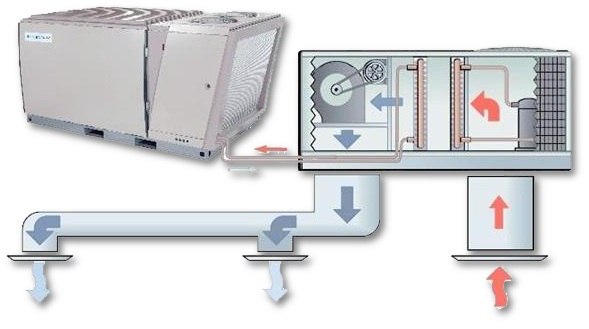Sunday, 28/12/2025 | 18:26 GMT+7
The world has come a long way from traditional radiators and window air-conditioning units as the only ways to heat and cool businesses and homes. These old-fashioned methods are considered by many emerging scientists and engineers to be inefficient and unnecessarily costly.
The following three innovations to the heating/cooling industries have inspired cost-effective and efficient methods to regulate temperatures in vastly different environments that can help improve environmental conditions as well as the everyday lives of the people who use them.
Personal Cloud / Local Warming
Professor Carlo Ratti, director of the Massachusetts Institute of Technology's SENSEable City Lab, and his team at MIT recently unveiled a new cooling technology referred to as the Personal Cloud orCloud Cast.
According to a press release, this system uses motion-tracking to provide people with a cloud of direct and localized cooling air.
"In the Cloud Cast installation, ultrasonic sensors embedded in the suspended canopy structure detect passers by interpreting the echoes from high frequency sound waves," said Ratti.

According to Ratti, the device measures the time interval between a sent signal and the echo of receiving it again, and uses that information to properly determine where a person is and how much space they are taking up.
"The effect is that of a responsive mist cloud activated by each passer-by," he said.
One of the goals of this product is to increase efficiency by emitting cooling only when there are actually people in the area to use it. That can allow businesses to save energy, which also saves money, by only using the required amount of energy to keep people comfortable.
"In some cases, our calculations show you could reduce energy consumption by 90 percent," Ratti said.
Cloud Cast was designed to be implemented in hot, arid climates where the temperatures during the summer months discourage people from going to places that do not have some sort of temperature control.
"The system would work less well in hot, humid climates, think for instance of tropical locations, as the higher humidity in the air makes evaporative cooling less efficient," Ratti said.
Ice Bear
"What the Ice Bear does for an air conditioner is we consume energy at night when the outside air temperatures are much cooler and when the efficiency of the grid is much higher because everything is running at partial lows," according to Greg Miller, executive vice president of market development at Ice Energy.
The Ice Bear is an energy storage technology that pushes warm air from buildings through a capsule containing ice that cools down the air and emits it back into the building it is serving.
Usually, energy is less expensive to buy during the nighttime hours since there is less demand that drives the prices down. Therefore, using a system like the Ice Bear can not only increase efficiency, but can also decrease total spending costs that businesses have, according to Miller.
Weather and climate play an important role in how efficiently this product works.

"The greater the differential between daytime and nighttime temperatures, the more efficiently we can provide cooling," Miller said.
For example, the system would be much more effective in a desert environment that has a large difference between their daytime highs and nighttime lows as opposed to somewhere like Southern California that, at times, does not exceed a 15-degree difference.
The product was initially developed for industrial buildings that have one or two stories, but last year Ice Energy started to create a prototype of a residential version of the technology that they hope to release in 2016.
Emerson Heat Pump Technology
Emerson Climate Technologies produces a long line of products designed to increase energy efficiency and convenience in a wide variety of climates. Their heat pump technology is one way that they bring decreased costs and increased environmental benefits into the homes of their customers.
According to Karl Zellmer, sales vice president of air conditioning at Emerson Climate Technologies, heat pumps are essentially central air conditioners that can take advantage of off-peak seasonal electricity to heat an entire house comfortably using one central device, which is more efficient than using multiple devices.
The system actually "runs in reverse" in the winter in order to heat the home so energy costs are much lower than other traditional methods of heating.
This technology is able to increase efficiency up to 20 percent compared to traditional heating methods, according to Emerson, especially in areas like China that have extremely high population densities. Heat pumps allow areas to reduce their reliance on coal-fired boilers, which can bring many benefits for the environment.
Yen Pham








 Webinar 2: “Financial Support for Energy Efficiency Enterprises – Opportunities and Challenges”
Webinar 2: “Financial Support for Energy Efficiency Enterprises – Opportunities and Challenges”
 Vietnamese enterprises achieve green growth and cut costs through energy efficiency
Vietnamese enterprises achieve green growth and cut costs through energy efficiency
 Capacity Building for Program Implementing Entity
Capacity Building for Program Implementing Entity
 Enhance Energy Efficiency Knowledge for Managers of Cement Industrial Enterprises
Enhance Energy Efficiency Knowledge for Managers of Cement Industrial Enterprises
 Capacity building for participating financial institutions of the VSUEE Project
Capacity building for participating financial institutions of the VSUEE Project
 Capacity building for participating financial institutions in Ho Chi Minh City
Capacity building for participating financial institutions in Ho Chi Minh City
 Strengthening capacity for energy management officers of local government agencies
Strengthening capacity for energy management officers of local government agencies